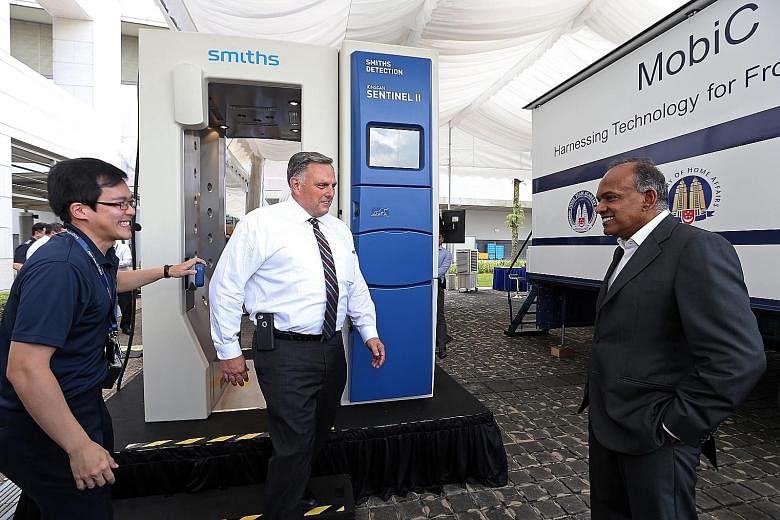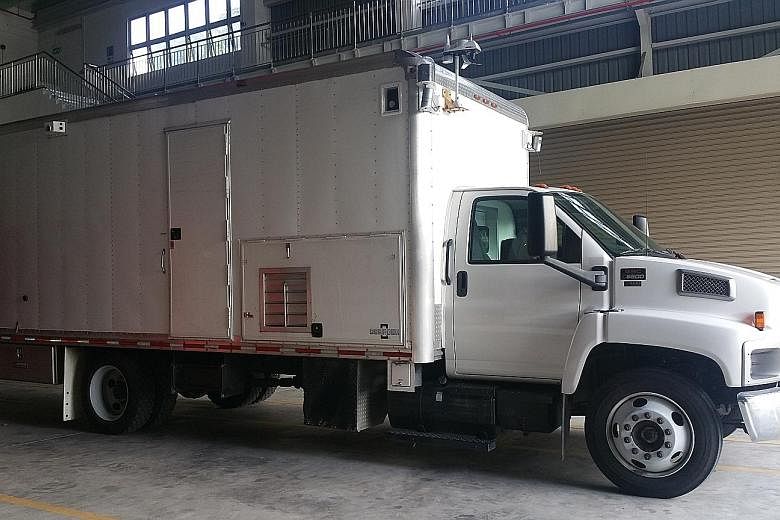Security at Singapore's entry points has been beefed up with facial recognition technology, laboratories that can detect biological threats and even a walk-through system that puffs air at individuals to allow for trace amounts of explosives to be detected.
Home Affairs and Law Minister K. Shanmugam revealed these and other technologies that the Home Team has adopted to secure the Republic's borders, at the opening of a science and technology exhibition and conference on homeland security yesterday.
He said a customised video analytics system, employed at Woodlands Checkpoint, has helped "identify many blacklisted travellers".
Besides real-time facial recognition, the system can be used to search recorded footage for objects based on factors such as colour and size, and vehicles by number plate recognition. It was introduced at the Woodlands Checkpoint bus hall in 2012, and a Home Affairs Ministry spokesman said there are plans to roll it out to all checkpoints in the next few years.
Speaking at the Home Team Academy, Mr Shanmugam said a network of labs across checkpoints also helps to detect and investigate chemical, biological, radiological, nuclear and explosive threats.
They can also analyse narcotics, including new psychoactive substances, strengthening the country's fight against drugs, he said.
"We have a shrinking manpower base, we have an ever-expanding number of travellers coming in, and people find new ways of trying to evade our checks," he told reporters on the sidelines of the exhibition. He noted that the land border between Malaysia and Singapore is the busiest in the world, with a few hundred thousand people crossing every day.
Yesterday's event also marked 10 years of cooperation in the field of science and technology with the United States Department of Homeland Security (DHS) - the Home Team's longest-running partnership with foreign counterparts in this area. Other partners include France, Germany and Britain.
"We work with international partners because we are a small place, and we need to benchmark ourselves against the best technology available," Mr Shanmugam said.
The Singapore-US collaboration resulted in the development of a walk-through system that releases puffs of air, dislodging particles on clothing and human bodies to help detect trace amounts of explosives and narcotics.
The Immigration and Checkpoints Authority deployed these portals at all land and sea checkpoints here in 2012.
It is one of many successful collaborations between the Home Team and the US DHS, which has shared its expertise, collaborated in trials, and co-developed capabilities with Singapore, said Mr Shanmugam.
A recent project produced a prototype truck last year that can identify and show where radioactive threats are in the environment. The truck's radiological analysis platform, which includes sensors and 3D-mapping technology, has been tested at land and sea checkpoints.
"The system was able to screen passenger vehicles, cargo containers, and conduct searches for threats in urban areas," said Mr Shanmugam. "It has, in our view, the potential to become an incredibly valuable tool to counter nuclear smuggling and terrorism."
Speaking at the event, US DHS Under Secretary (Acting) for Science and Technology, Mr William Bryan, said: "Recent acts of terror around the world serve as reminders that as hard as we work to protect and secure our borders and our way of life, there are people out there deliberately trying to disrupt that.
"Such universal challenges highlight the role science and technology can play to deliver solutions."



